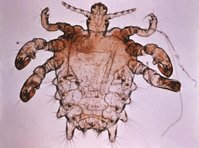People can be infested with three types of lice: body lice, head lice and crab or pubic lice. Body lice are associated with severe systemic diseases such as typhus and trench fever. Infestations with crab lice usually follow sexual or intimate contact. Head lice are thought to be the most common type and are developing resistance to commonly used pediculicides. Every year, between six and 12 million people in the United States, primarily children three to 10 years of age, are infested with head lice. Girls are at greater risk because they have more frequent head-to-head contact.
Head lice affect people across the socioeconomic spectrum. Mazurek and Lee described the life cycle of head lice and reviewed the management of infestations. Head lice are obligate ectoparasites that live on human skin and survive on human blood. No other animal is infested. Head lice die if they are away from the host head for more than two days. Lice are wingless and cannot jump, but they climb quickly from hair to hair when the hair is dry. Lice move slowly on wet hair and can be removed more easily with a gloved hand or a fine-toothed comb.
The adult female louse lays seven to 10 eggs daily that attach to human hair with a glue-like, water-soluble substance. Eggs found close to the scalp are the most viable, because heat and moisture in this area incubate them. By seven to 10 days, a nymph emerges from the egg and is close enough to the scalp to obtain its first meal of blood. Adult lice, after the seven- to 10-day period of molting stages, live about 30 days. Infested people usually have no more than 10 to 12 live head lice at a time but can harbor hundreds of eggs and nits. Head lice bites result in itching and a sensation of "something crawling on my head." Scratching may cause excoriations and secondary infection. Most infestations, however, are asymptomatic.
Before treatment, live lice must be identified under a magnifying glass, which is best done when the hair is wet. After infestation is confirmed, treatment consists of application of a pediculicidal agent to the hair, followed by mechanical removal. The hair should not be washed for two to three days after the pediculicide is applied. Thorough physical removal of lice with a sturdy, fine-tooth comb is recommended for several days after application because no pediculicide guarantees total eradication of lice. All household members with active infestation should be treated simultaneously. For children younger than two years, there is no recommended pediculicide; therefore, treatment consists of manual removal only.
Lice that remain as active eight to 12 hours after treatment as they did before treatment may require an alternative agent. Retreatment seven to 10 days later also is recommended to kill any newly hatched lice. Itching may persist for up to 10 days after successful treatment and should not be mistaken for treatment failure. Lice rarely survive off the host for more than a couple of days, so the value of thorough cleaning of the environment is uncertain. However, the Centers for Disease Control and Prevention still recommend that all clothing and bedding in contact with the infested person during the two days before application of the pediculicide be laundered in hot water and machine dried using a hot dry cycle. All nonwashable items should be quarantined in a plastic bag for two weeks. Combs and brushes should be disinfected with hot water or alcohol.
First-line topical agents containing pyrethrins or permethrin are available over the counter and are relatively nontoxic. Retreatment is advised seven to 10 days after the first application of pyrethrins. Because permethrin remains active for a longer period, retreatment generally is not necessary. Permethrin 5 percent cream is available by prescription for use in resistant cases. Alternative agents include lindane or malathion. Lindane has been shown to have limited success and is systemically absorbed, so its use is now considered second-line. Malathion was recently labeled by the U.S. Food and Drug Administration for the treatment of head lice and is available in a lotion that is left on the head for eight to 12 hours. Oral agents include ivermectin and trimethoprim-sulfamethoxizole. For a list of agents used to kill head lice, directions for their use, indications for retreatment and possible side effects, see the accompanying table. Resistance is possible with any treatment because of reduced susceptibility or incorrect use of the medication.
COPYRIGHT 2000 American Academy of Family Physicians
COPYRIGHT 2000 Gale Group



